Wagner cast iron cookware is regarded by many as some of the finest examples of 19th and 20th century cast iron. Much of the cast iron is over 100 years old and still usable today. These antique pans are sought-after by enthusiasts who prefer vintage cast iron to newer pans. But identifying and dating these old Wagner Ware Sidney -o-pans can be tricky.
So, with this article, I hope to help you and other proud owners identify and give an estimate of the age of your cookware. You can also learn the history of your cast iron, which the Wagner Manufacturing Company manufactured.
Table Of Contents
- Wagner cast iron. “Why is it so collectible?”
- Learn the history of the Wagner Manufacturing Company.
- Where you can buy Wagner cast iron.
- Considerations when purchasing Wagner cast iron cookware.
- You can identify and date antique Wagner cast iron using trademarks and logos.
- Final thoughts on collecting vintage Wagner Ware cast iron.
But first, here is a quick look at the Wagner Manufacturing Company.
Identify And Date Your Wagner Cast Iron Skillets Using Logos. Also, Learn The Fascinating History Of Wagner Manufacturing.
Background To Wagner Manufacturing Cast Iron.
Founders | Milton M. Wagner and Bernard P. Wagner |
Operational Dates | The foundry in Sidney operated from 1891-1959 |
Located | The Wagner Manufacturing foundry was in Sidney, Shelby County, Ohio. |
Product Line | Wagner was one of the largest American manufacturers of cast iron products in the 20th century. Their product line included skillets, kettles, bean pots, Dutch Ovens, roasters, fruit presses, scoops, broilers, Griddles, waffle irons, muffin pans, and cornbread pans. The company also had a range of aluminum cookware. |
Wagner Brands | Wagner labeled their cookware under the following names: Wagner, Wagner Ware Sidney -o-, Wagner Ware, National, Long Life, Magnalite, Wardway, and Ward’s Cast Iron. |
Signature Products | Wagner is best known for the Sidney -O- range of skillets and Dutch Ovens. |
Reason For Closure | The reason for the closure of the foundry came from two fronts. Firstly, the Wagner family sold their interests in the company in 1953 to the Randell Company. Secondly, the company struggled financially because of a drop in sales. The decline in sales was due to two World Wars, the Great Depression, the development of new cookware materials, and the increase of lower-priced imports from Asia |
Wagner After Buyout (Non-Collectible) | In 1957, the Randall Company purchased long-term competitor Griswold from McGraw Edison. The Randall Company sold the cast iron businesses to Textron Corp in 1959. General Housewares Corporation bought Textron in 1969. In 1994, the production of Wagner Ware ended. |
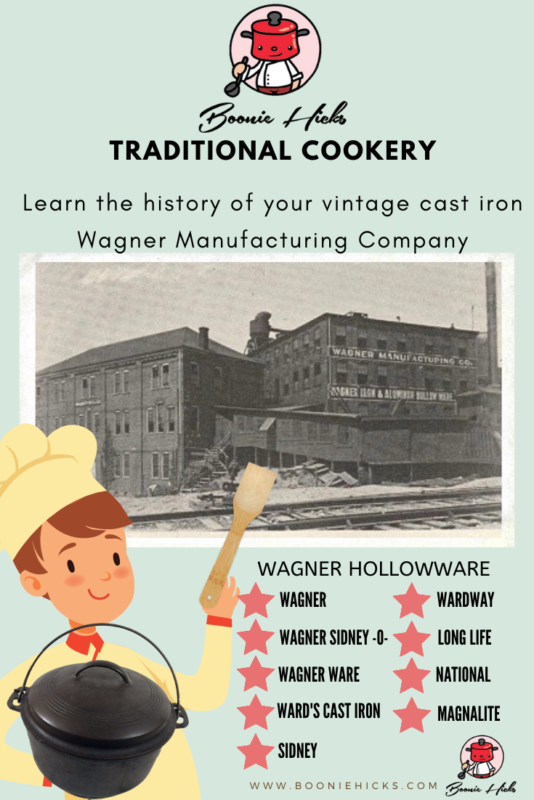
Why Is Wagner Cast Iron Collectible?
Super Smooth Cooking Surface.
Wagner cast iron is highly collectible. Like most antique cast iron, Wagner manufactured high-quality cookware for their entire range of cast iron products.
Unlike Wapak cast iron ironware, it often has characteristic casting flaws. Wagner cast iron tends to have a few casting flaws, resulting in very smooth cookware on both the interior and exterior of the cookware.
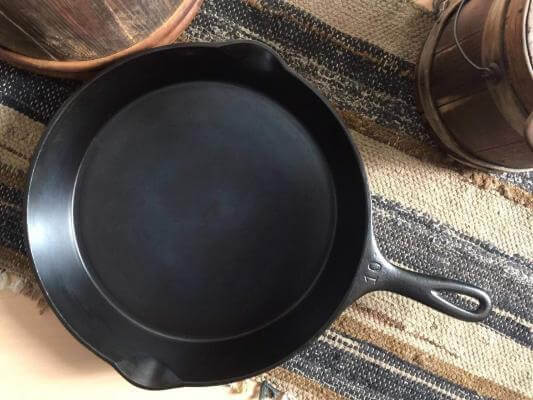
Focus On Quality
Imagine that workers would have worked on individual pieces of ironware. It was machined to smooth the interior and exterior of each pan. You can only see this level of detail in high-end cast iron cookware such as Le Creuset and Staub.
Today, Le Creuset and Staub benefit from combining traditional and modern manufacturing methods. However, the workers at Wagner could make cast iron cookware without casting flaws or bubbles. Must have taken great skill and attention to detail.
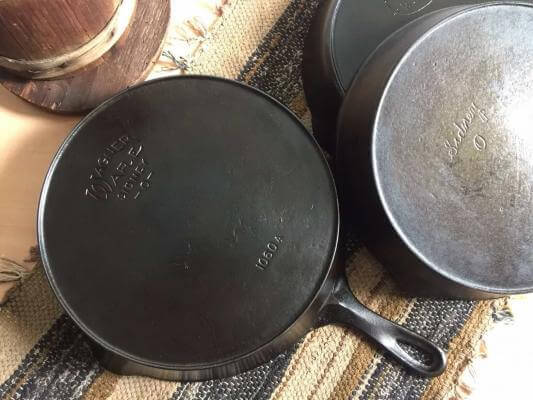
Wagner Made A Wide Range Of Cast Iron Cookware.
You can’t go wrong with an old Wagner cast iron skillet. It will serve you well for years, and they’re great fun. However, you may want to consider a Wagner Dutch oven. They are super smooth, and just like the skillets, they are reasonably priced. You can also buy cast iron muffin pans, which can be pretty cheap. But watch out for shipping costs that can increase the overall price drastically. Some of Wagner cast-iron cookware range includes:
- Dutch ovens
- Griddles
- Gem pans
- Waffle irons
- Skillets
You can even collect Wagner cast iron cornbread pans that look like corn cobs. Wagner Manufacturing also produced aluminum cookware, which must have seemed revolutionary.
Collect Your Favorite Logo.
If you want a vintage skillet, then Wagner skillets are a great choice. You can choose from sixteen different logos and trademarks or markings. I like pans with heat rings, while others may prefer a pan with a smooth base.
I think this wide selection makes Wagner cookware more collectible than other manufacturers, such as Vollrath and Martin Stove and Range, which manufacture a limited range of products.
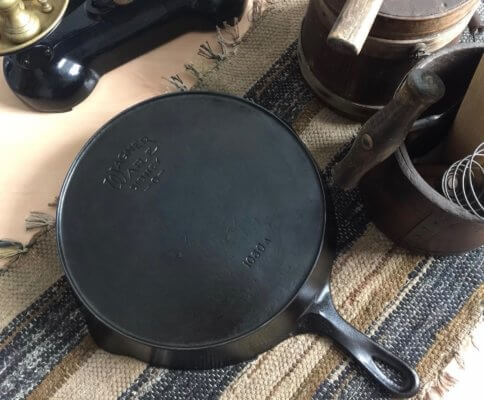
Wagner Manufacturing Company Focused On Quality Over Quantity.
Quality was a focus from the very start for Wagner Manufacturing Company. They even advertised this selling point to consumers. Old advertisements read;
We do not strive to manufacture hollowware as cheaply as possible but as well as it can be made. We cannot afford to put on the market ware that will not sustain our reputation. The name Wagner is on the bottom of each piece of ware.
Wagner Manufacturing Company History
Founders And Foundry
Who Founded Wagner Manufacturing? | Wagner Manufacturing Company was founded in 1891 by Milton M. and Bernard P. Wagner. However, two more Wagner brothers, Louis and William Wagner, joined the company in the following years. Another key player in the foundation of the company was R. Bingham. Bingham previously worked at Marion Stove Company and the Sidney Manufacturing Company. |
Where Was Wagner Cast Iron And Wagner Ware Made? | The company had its ironworks in Sidney, Shelby County, Ohio. Early cookware from Wagner Manufacturing had a simple Wagner marking on the back of the ironware. Wagner included Sidney O. in their cookware around 1895. The term Wagner Ware first appeared in the logo in the 1920s. |
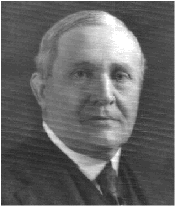
The Wagner Product Line Added Nickel Plating, Aluminum, And Magnalite.
Nickel-Plated Cast Iron | To complement their cast iron range, Wagner added a nickel-plated range. Unlike cast iron and copper pots, nickel plating does not react to acidic foods such as tomatoes, which can taint food. It’s easy to look past the development of nickel-plating. But, in the 19th century, bonding two metals together would have required much metal casting expertise. |
Aluminum Cookware | Along with nickel-plated cast iron, the Wagner brothers in 1894 manufactured a line of aluminum cookware, and Wagner Manufacturing was one of the first companies to do so. |
| Aluminum Cookware Exported To Europe | By 1913, Wagner cast iron and aluminum products were selling in Europe. |
| Magnalite | In the 1930s, Wagner manufactured a cookware line with a patented aluminum alloy called Magnalite. |
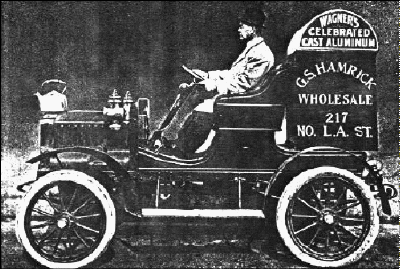
Wagner Manufacturing Buys Their Sidney Competition.
| Wagner Bought Sidney Hollowware Company. | In 1897, Wagner bought the Sidney-based competitor Sidney Hollow Ware Co. from the founder and owner Phillip Smith. Sidney Hollow Ware made high-quality cast iron cookware that was extremely light and smooth. Sidney Hollow Ware Co. was also an early adopter of nickel-plating cast iron. |
Why Did Wagner Buy Sidney Hollow Ware Company? | It was a brilliant idea to buy the Sidney Hollow Ware Company. After all, Wagner Manufacturing and Sidney competed in the same city and made comparable products. However, it was common knowledge that Smith made a tidy profit from his original investment in the foundry. To run the Sidney Foundry, William H. Wagner joined the family business to oversee the operation. |
Wagner Sold Sidney Hollow Ware Back To Phillip Smith. | In 1903, Wagner Manufacturing sold the Sidney Hollow Ware Company to the founder, Phillip Smith. Sadly, Phillip Smith did not reopen the foundry due to health reasons. |
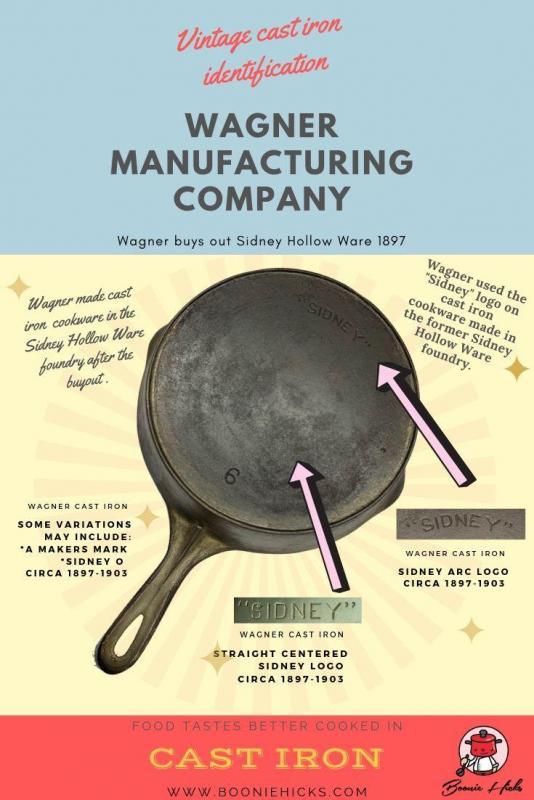
Wagner Introduced A New Product Line To Stop A Decline In Sales.
| The Great Depression (Magnalite) | I have to take my hats off to Wagner because they introduced a new product line called Magnalite in one of the deepest recessions the world has ever seen. Wagner Manufacturing was steadfast in making only quality products. For this reason, the cookware is collected and highly usable. |
| The Sales Decline | Wagner introduced Magnalite to stop falling sales at Wagner Manufacturing; it was not due to their product range. Magnalite was hugely popular, but it could not offset the effect of the worldwide recession. From 1929-1941, the US was in the grips of what we now call the Great Depression. Therefore, it was not only Wagner. However, many foundries struggled financially to survive. Many didn’t. |
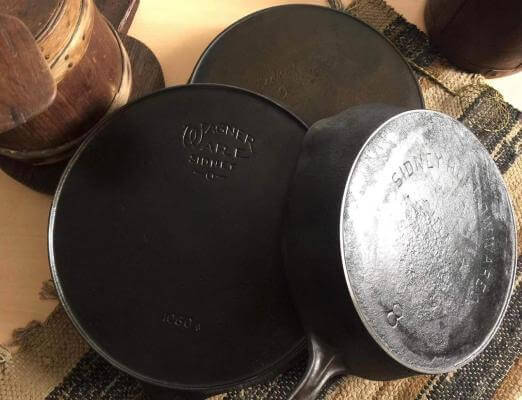
The Family Sells Their Interest In The Foundry.
Wagner Family Sells The Company To Randall Corp. | Wagner Manufacturing Co. lasted longer than many foundries. However, in 1952, Wagner was sold to the Randall Company. Unbelievably, the Randall Company was a car parts manufacturer. |
Textron Buys Randall | In 1959, another business called Tetron bought Wagner. Textron also purchases Griswold Manufacturing Company. At this date, cast iron enthusiasts consider this the end of Wagner Ware production. Wagner cast iron pans made after this date are considered not collectible. |
General House Wares | General Housewares Corporation in 1969 bought the rights of Griswold and Wagner. |
Is Wagner Ware Still Made? | With the world rediscovering cast iron cookware, will we see Wagner Ware skillets manufactured again? General Houses Ware stopped the manufacture of Wagner Ware in 1994. However, there is a glimmer of hope for Wagner Ware. In 2014, American Culinary bought both the Wagner and Griswold trademarks. So, fingers crossed, cast-iron fans may one day decide to manufacture Wagner cast iron again. |
Where Can You Get Your Hands On Some Wagner Ware?
- Grandparents (best deal and great to keep your heritage in the family).
- Antique stores (check online to compare the store price).
- Garage sales (rescue those poor skillets from the tip).
- Flea markets (search the markets for hidden gems).
- Online (largest selection available; however, asking prices can vary greatly.
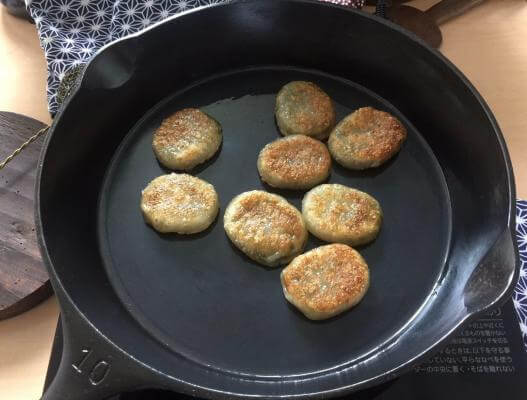
Buying Considerations Before You Buy Antique Wagner Ware
There Is Plenty Of Wagner Cast Iron Around, So Take Your Time.
There is no shortage of Wagner cast iron. Wagner had a large percentage of the cookware market back in its heyday. And plenty of fantastic Wagner skillets and Dutch ovens are in excellent condition.
What Size Skillet Or Dutch Oven Suits Your Needs?
The first thing you may want to think about is the size you need. There are often plenty of #8 skillets around. This size seems to be the most common for Wagner skillets and other vintage cast iron manufacturers, such as Favorite Piqua.
Inspect Carefully Since A Lot Of Wagner Ware Is Nickel-Plated.
Check the cookware carefully. The Wagner Manufacturing Company was an early adopter of nickel plating. However, most of Wagner cookware is unplated iron. Heavy seasoning may hide nickel plating. Nickel-plated can wear off or be patchy in places. Take a close look before purchasing.
Would You Like A Wagner Ware Skillet With A Smooth Bottom Or Heat Ring?
Do you want a pan with a smooth bottom or one with a heat ring? The older Wagner Ware skillets will have a heat ring, while the later-made pans have a smooth, flat base. It is a personal preference. I tend to like the older skillets with heat rings. They have more character, but the smooth-bottom Wagner cookware tends to be a little cheaper. And they are great cooking pans, too.
Does The Cookware Sit Flat?
As with all antique cast iron, asking the seller if the pan sits flat could be a good idea. A lever base is practical if cooking on a flat surface such as induction or glass.
Learn To Date And Identify Your Wagner Cast Iron Using Logos And Markings.
Although I’ve researched carefully, please only use the dates as an approximation.
Wagner cast iron cookware, to my knowledge, has sixteen known logos, brands, or markings. These include:
Straight Wagner Logo 1890s-1915
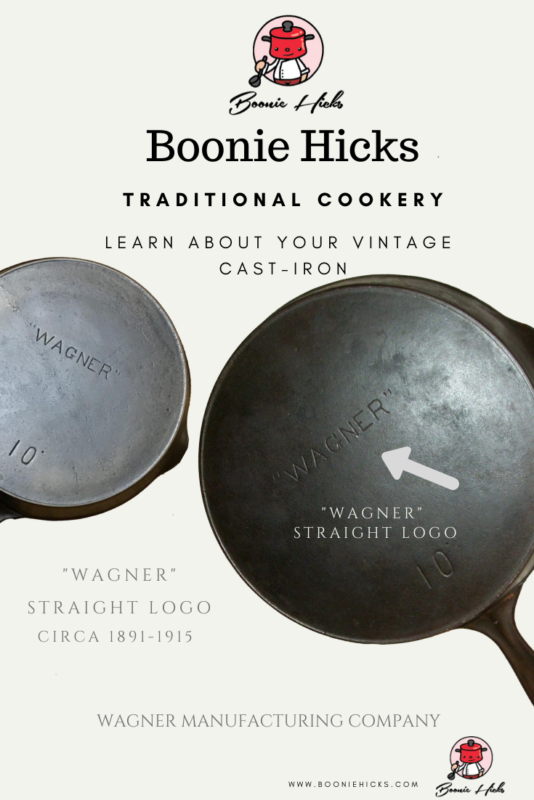
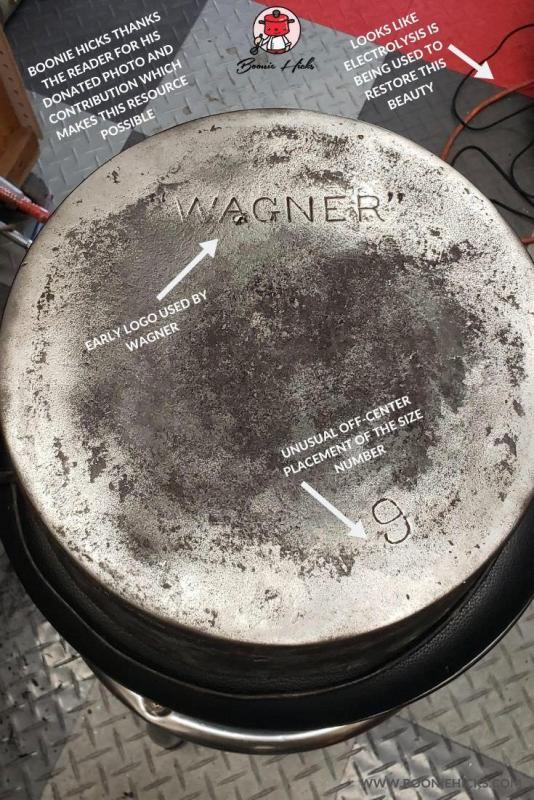
Wagner Arc Logo 1891-1910
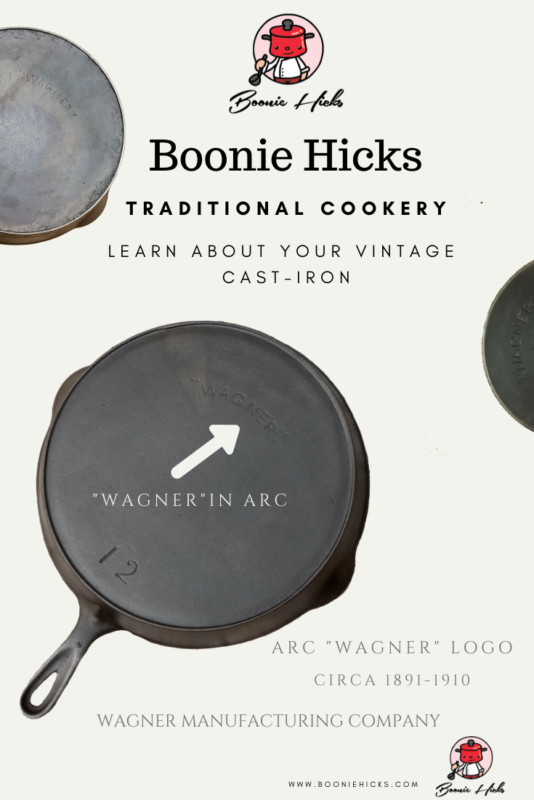

Double Arc Wagner Sidney O 1895-1915
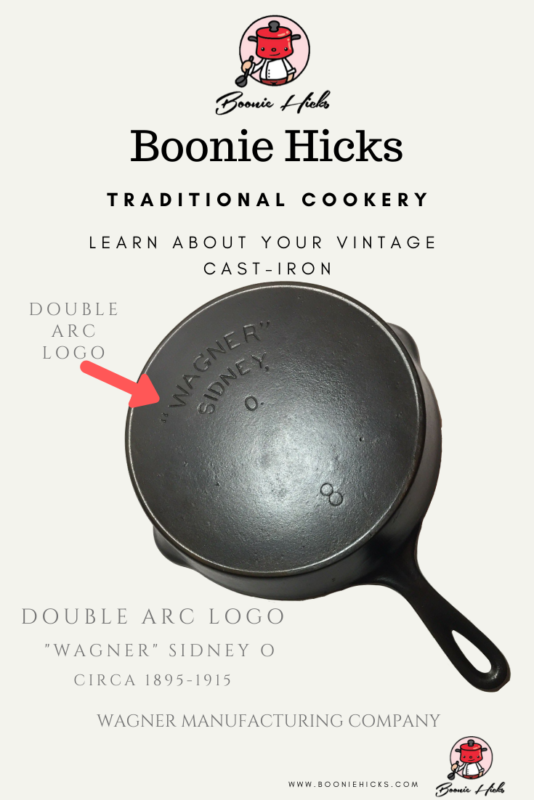
Sidney Arc logo Circa 1897-1903.
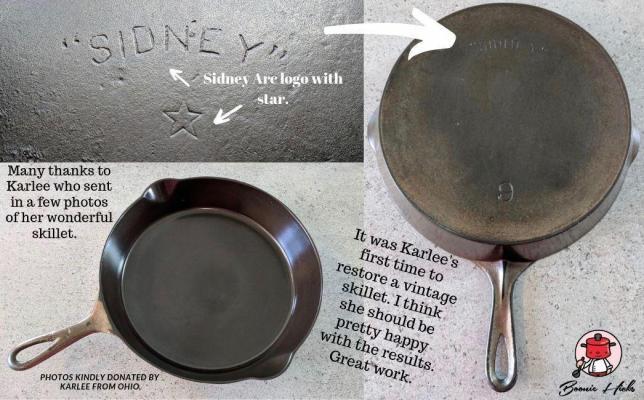
Straight Sidney Logo Circa 1897-1903.
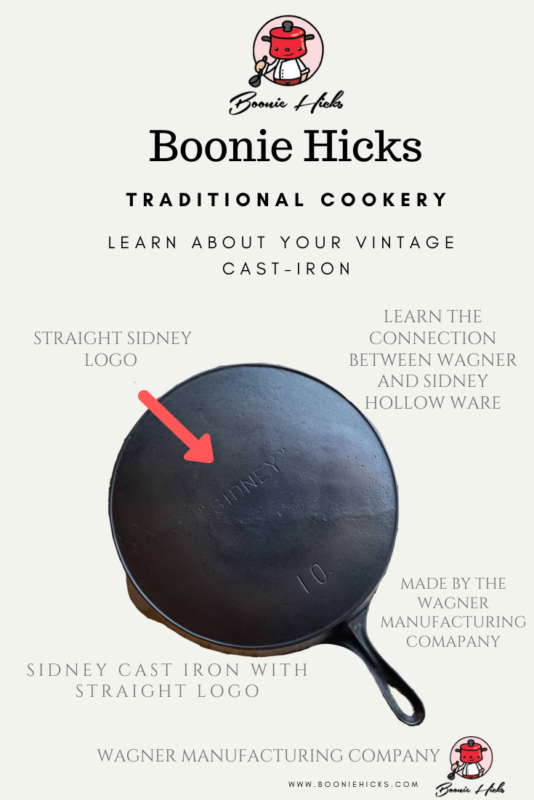
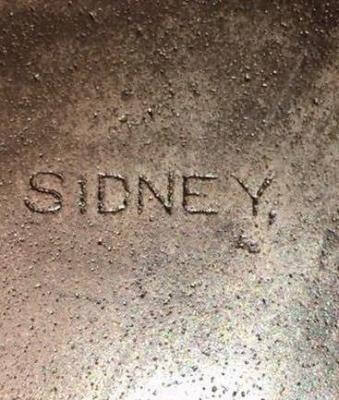
Straight Wagner Sidney O. (Centered.) 1910-1915
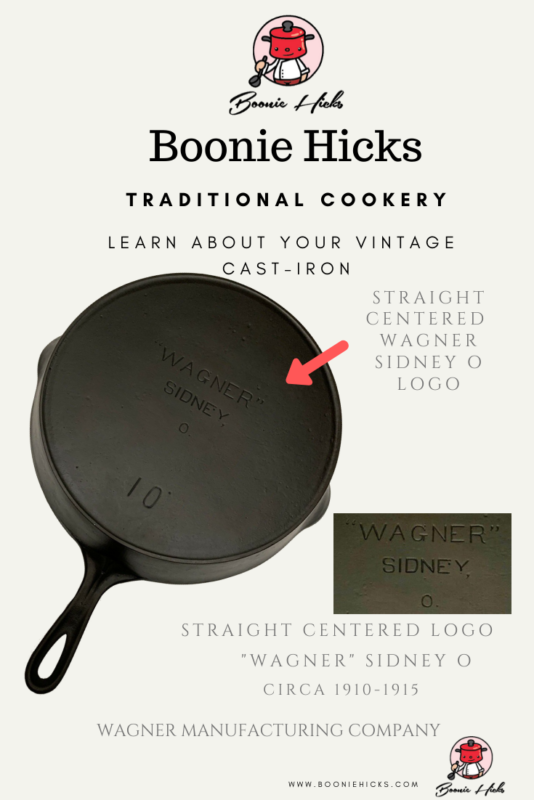
Wagner Sidney O. Wagner Slightly Arced While The Sidney Lettering Is Straight. Circa 1915-1920s
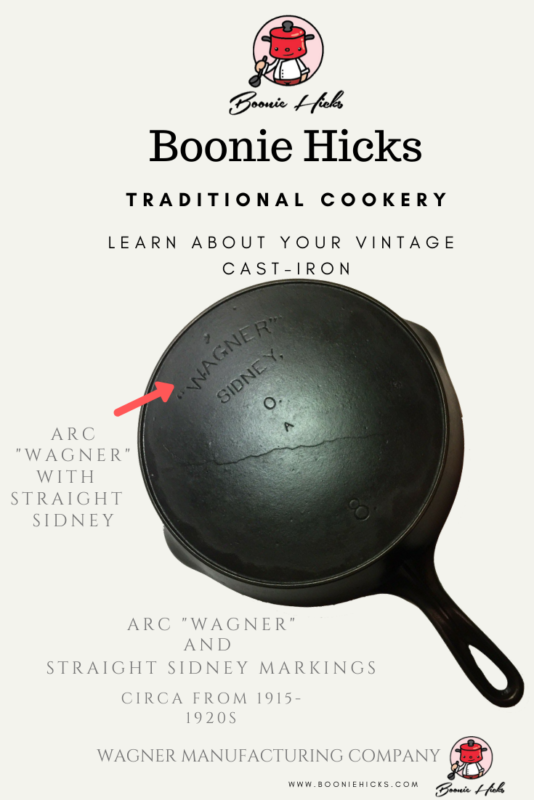
First Wagner Ware Sidney O. With Arc Wagner And Straight Ware And Sidney. Circa 1920s.
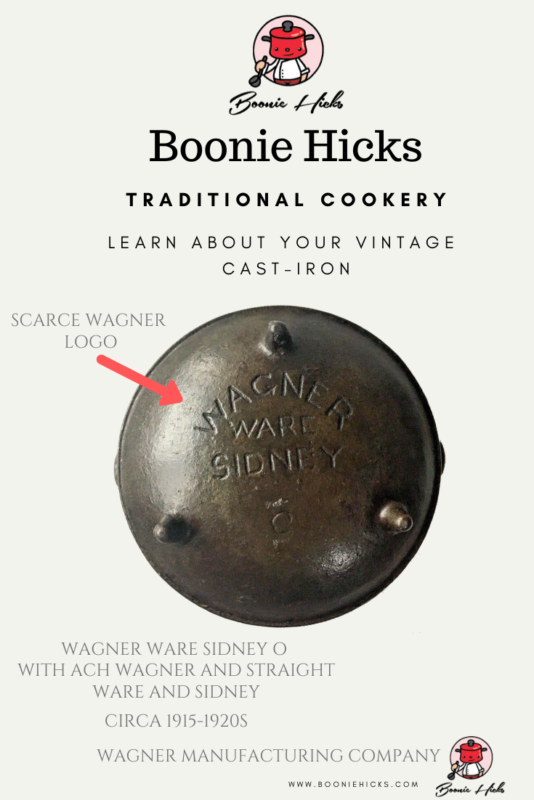
Stylized Wagner Ware Sidney O. for regular skillets. Circa 1920-1924 with heat ring and single-digit size number. 1924-1935 with a heat ring and a four-digit pattern number. Around 1935-1959, for skillets with no heat ring.
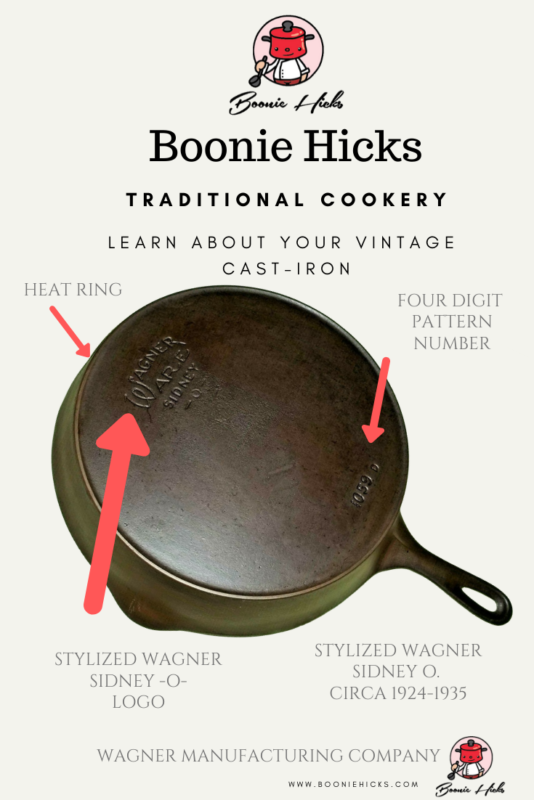
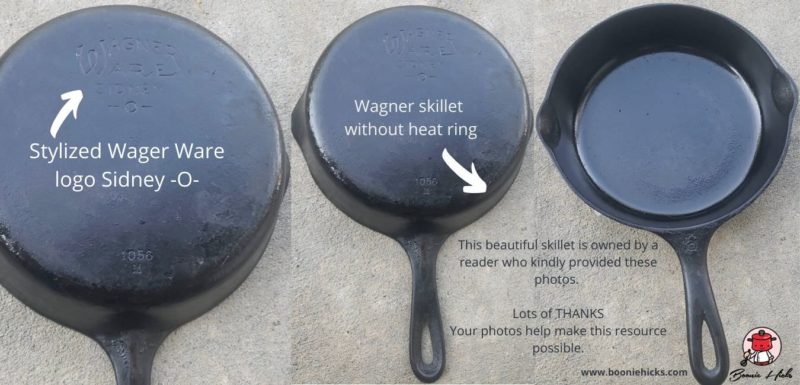
Centralized Stylized Wagner Sidney O. 1924-1935 With Heat Ring.
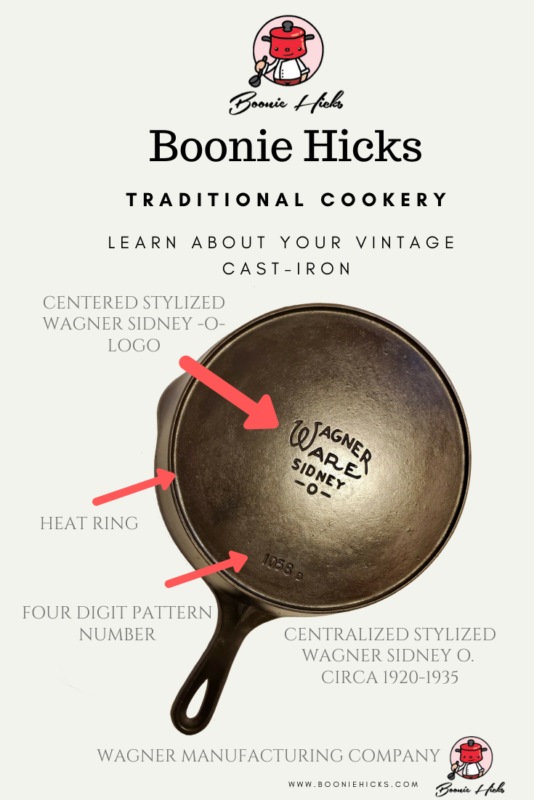
Pie Logo 1924-1934. However, Manufacturing Dates Are Uncertain.
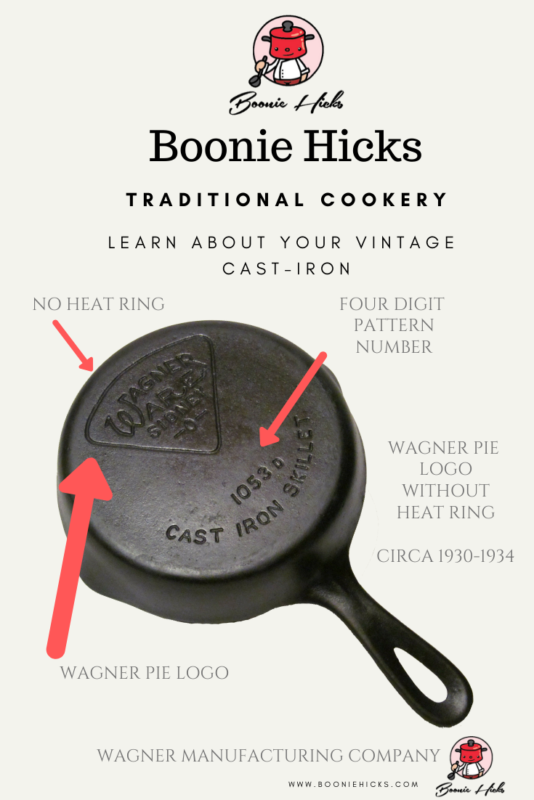
National Cast Iron Dates Between 1914 and 1940s
There are several different versions of cast iron with the National marking. Wanger marketed the Nation brand as entry-level cookware for budget-conscious consumers. Wagner made the National line circa 1914 to 1940.
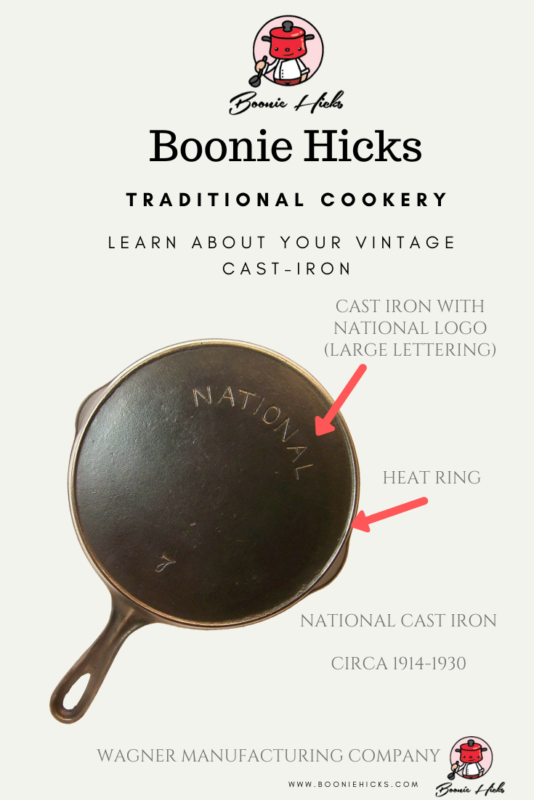
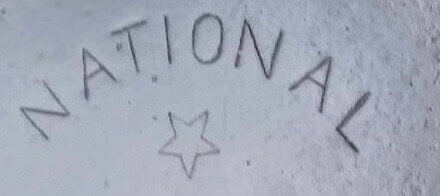
Long Life Logo 1930s.
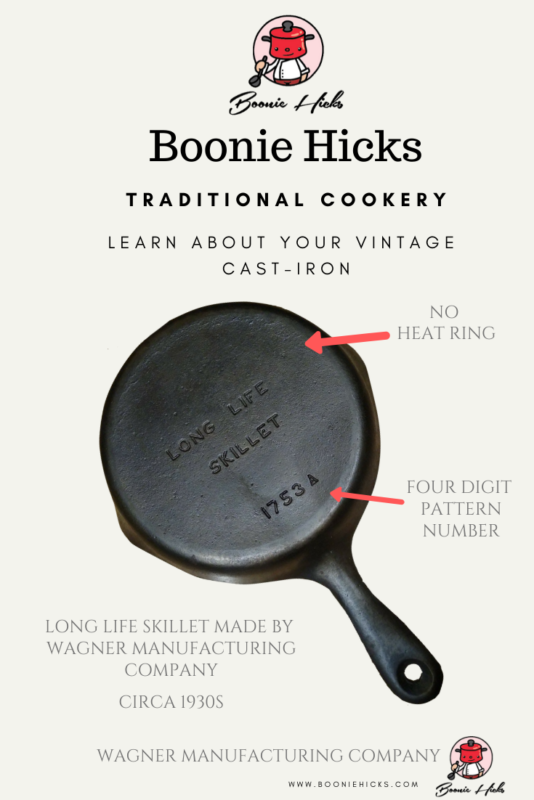
Wardway and Montgomery Ward. The Montgomery Ward Department store contracted Wagner Manufacturing Company to produce an in-store label. Circa the 1930s.
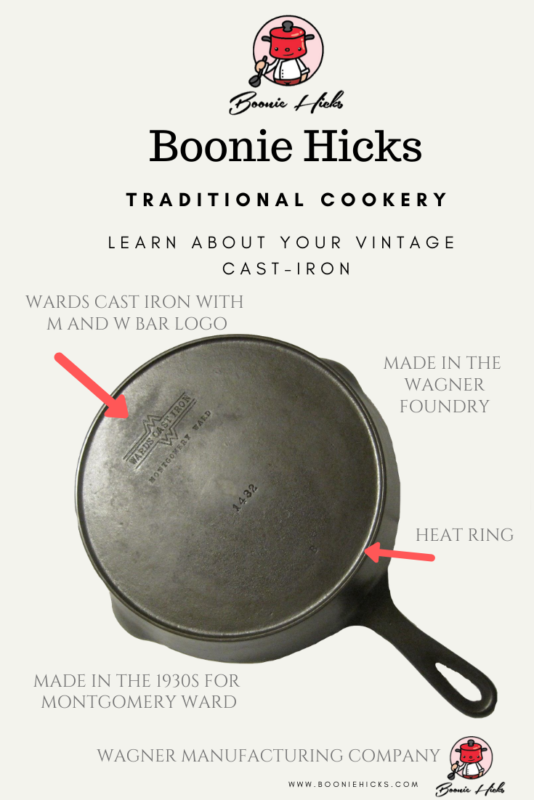
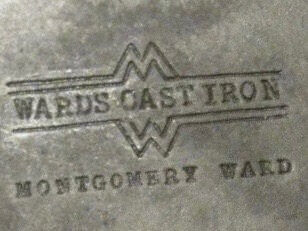
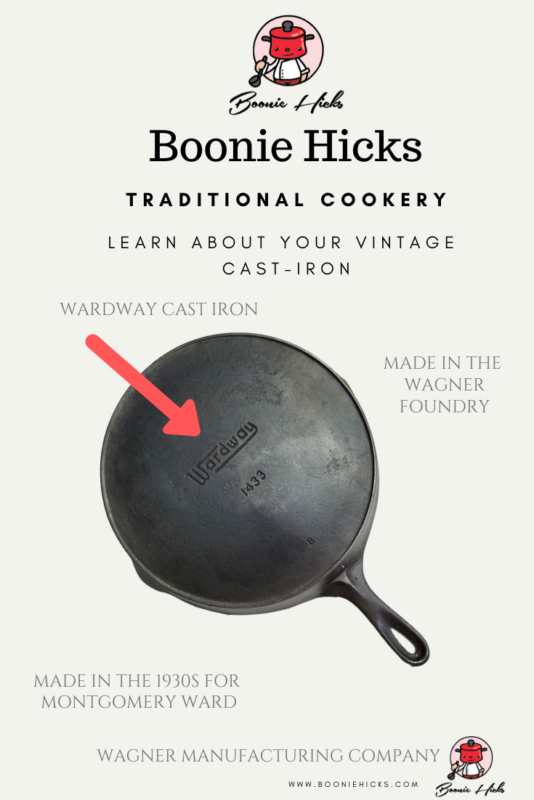
Final Thoughts On Wagner Cast Iron.
Fortunately, Wagner cast iron is more straightforward to date than other foundries of the time. Wagner Ware also has a huge collector base, so dates are well documented. The Cast Iron Collector is a valuable online resource for enthusiasts. Also, there are Facebook groups where you can share your love of cast iron cookware.
The Wagner Manufacturing Company was known for quality over quantity. Therefore, it has a good reputation for making trustworthy products.
Today, collectors and enthusiasts seek out Wagner cookware. However, you don’t need to be a collector to enjoy vintage cast iron. Here are six reasons why Wagner Ware is excellent ironware.
Although many cast iron enthusiasts look for Wagner-made skillets. But you’re not limited there. Wagner Manufactures a wide selection of cast iron cookware. You may find yourself becoming interested in:
- muffin pans
- Dutch ovens
- Scotch bowls
Since Wagner made some of the finest cast iron of the 19th and 20th centuries, Wagner ironware is still sought-after by cast-iron fans and hobbyists alike.

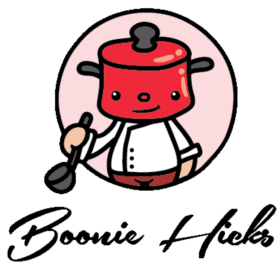
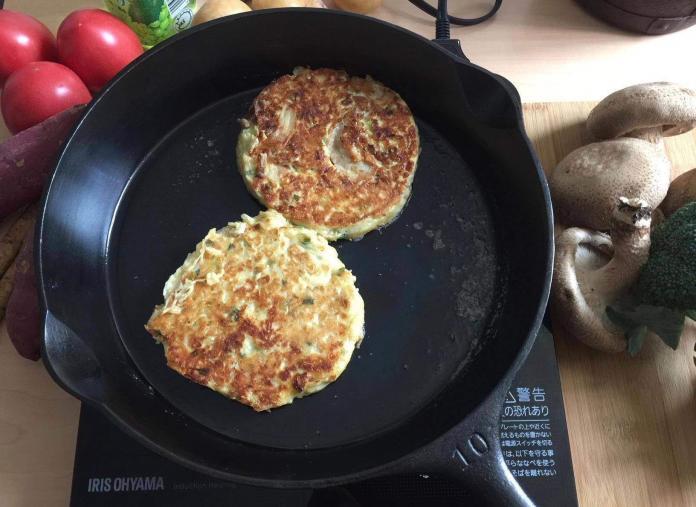
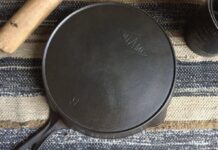
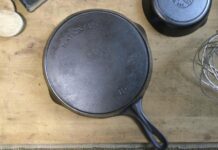
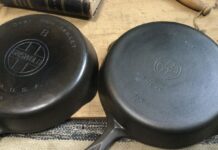



I have a skillet I suspect is a Wagner, but it does not have a name. It simply says 6 1/2 inch skillet on the bottom with a Q below that as well as a Q on the bottom of the handle. There is a 3 on the top of the handle. Could this be a Wagner? Is there a time that Wagner made unmarked pans?
Hi Chris
Thanks for getting in touch. From your description, it sounds like you have an unmarked Wagner. The size description and corresponding capitalized letters at 6 o’clock on the back of the handle are two telltale signs. I’d also like to see the handle flatten in a triangular shape where the handle meets the pans for Wagner identification.
It is hard to place a concrete date of manufacture on any unmarked skillet. And many collectors give an approximation. For me, these skillets have a mid-century look and feel to them. I believe these skillets around the late 1950s to early 1960s. Some collectors may place some unmarked Wagner pans earlier than this date. But this is what makes collecting vintage ironware fun and interesting.
Happy cooking
Boonie you are a Joy!
Your sentiments and valuations are spot on.
The love for these finely made American Cast Iron Skillets are entrenched in the meals you have made in them for the people you care about. There is time to pause and think as a pan slowly comes up to temp. And anticipation of flavor that comes with every meal.
The strength and durability has no fear of gravity or heat. Yours should be the concern of what it fell on. If these pans could talk the stories they would tell! Can you imagine?
Thanks for your love and help with all the marvelous history and dating info. Nobody does Bacon like a Wagner and you can take that to the BANK!
Hi Tracy
Thanks for sharing. I agree these old 19th and 20th century pans have seen some of the best of times and some of the hardest. The stories they could tell. It’s brilliant that cooking with cast iron remains as popular as ever. And that it’s become part of America’s cultural heritage that reminds us of our past. I guess that what makes using vintage ironware so special.
Have fun using your Wagner Tracy.
Just today I’ve bought a “Wagner” No. 8 long griddle. No other marks at all. The end handles are curved inwards on the longest part. There is no photograph of similar on the internet. This may be quite rare from before WWI.
I’d like to see if it’s the only one in collectors hands possibly?
Thanks Much For Your Knowledge !
Photo;
https://i.postimg.cc/PrGmQgLW/Wagner-1912-Griddle.jpg
Hi Rob
Well done on your purchase. I have not seen a Wagner with inward curved handles. And the block WAGNER logo without Sidney O indicates old iron. It’s possibly from the late 1890s to early 1910s. Fantastic.
I’m sure it’s cooking to cook up a storm.
Hi Boonie – Thanks for compiling such detailed information for Wagner. I’ve been able to date one of my pans and am having trouble dating another.
We acquired a 12 skillet. “Wagner” is in block caps, curved line with Sidney below in block caps straight line and O below. 1062 is stamped centered just above the handle. It does have a fire ring. 12 is stamped on the top of the handle near the pan.
Thank you for your assistance.
Hi Joyce
It sounds like you have a neat old skillet manufactured before the stylized logo. Because your skillet has a pattern number, I suspect your skillet was from the early to mid-1920s. Wagner may have manufactured skillets with this pattern number in the 1930s. But I guess production was moving more to the stylized logo by this time.
I hope this helps Joyce.
I have a little #3 skillet that some have said is called a Mercedes skillet. I believe it is a Wagner and may have been made for only a short time. I can find very little (if any!) info on this little pan. Can you give me any info on this? Thanks
Hi Karen
Thanks for getting in touch.
I cannot confirm the manufacturers of Wagner ironware produced these skillets. However, several Wagner design features on Mercedes skillets include a capitalized letter under the handle.
The design with the three raised bars is likely for use on electric stoves with coil elements. I’m not sure of the date of manufacture, but it’s highly likely to be post-1960s. And it’s undoubtedly a fantastic skillet to use.
Have fun.
I have a very large Cauldron marked Wagner mfg co #6 Sydney oh. I would love to know the history behind it
Hi Jeff
It’s surprising how many different types of old kettles Wagner produced. Since many were used on outside tripods or on chimney cranes. Most were manufactured from the 1890s to 1920s. You have a wonderful piece of cast iron history.
Have fun using your antique kettle.
My husband bought me a 14” cast iron skillet. The seller claims it is Wagner, but it is unmarked. The bottom of the skillet is marked “14 inch skillet” and “Made in the USA” so I know it is post 1960. The bottom of the skillet as well as the handle are marked with a B. The top of the handle is marked with a 12. The bottom of the handle does also seem to indicate the triangle typical of Wagner. I know that post 1960 is not as collectible, but how much would something like this be worth? He paid about $250 for it. Did he overpay?
Hi Michelle
Thanks for getting in touch. The markings on the skillet sound like it is a Wagner.
The made-in-the-USA marking is near the handle on Wagner pieces.
You’re lucky to receive a treasured gift from your husband. Size 14 skillets are not cheap, even if they are unmarked.
I don’t touch on valuations, but I trust you consider your skillet priceless as you have received from a loved one.
I hope to have a size 14 someday, have fun.
Hey there,
I purchased two skillets. One had a#6 stamped on the handle, and on the bottom, it has WAGNER in an arch. Below that is the word WARE and then SIDNEY. There is also the number 1056N
The second is a #8 skillet that has the same markings, but the number is different. It is #1058M.
Any information would be helpful.
Hi John
Thanks for the contact and detailed description. It sounds like you might have an arc Wagner with pattern number. And if you didn’t see a photo in the article, this could be the case.
If so, your pan could be from the early 1920s-1930s. Very neat I haven’t seen one, to be honest. Lucky you.
I hope this helps and enjoy your pans.
Can you tell me anything about this Wagner cast iron pan? Any information would be appreciated. Date manufactured would be especially helpful.
Hi Boonie
I have a skillet that is 12 inches square. It has the words Wagner, Sidney Ohio USA in a raised oval ring. And then on the bottom, it has the size in inches and centimeters. With the markings A 6 – 97.
Thank you for your help.
Hi Linda
It’s nice to hear from you. Thanks for your clear description.
I think these were made by the General Housewares Corporation. I’m not sure of the date of manufacture, but I suspect it’s from the 1970-1980s era.
Hope this helps
Hello Boonie
I have one with the double arch WAGNER WARE logo, SIDNEY, -0-. And the #8 on the handle. The serial number is 1058Y. No heat ring. It is in good shape. I would appreciate any info. Very nice page you have set up.
Hi Brad
The double arc is an early logo. But from your description, I believe you probably have a Wagner Ware with a stylized logo. This is because your pan has a four-digit pattern number and a flat base. So it sounds like your skillet was designed for electric stovetops rather than a wood range. If this is the case, I believe you have a pan probably from the mid-1930s to the 1950s.
Hope this points you in the right direction.
Thank you for your great historical info. We inherited in the early 80s a cast iron Griddle for my husband’s Uncle, who was near 90 at that time. It is a Wagner Ware Sidney O with the marking 1109 stamped on the bottom. Was it made before 1935?
Thanks for any help.
Hi Stephanie
I am happy to hear that you have enjoyed reading about antique ironware. The four-digit number on the base of the Griddle can give a good indication of age. And your hand Griddle is likely to be made between the 1930s to the 1950s.
Cheers Steph, hope this helps.
Hi Boonie
I just picked up a lovely Wagner Ware, Sidney, Ohio Cast Iron Tea Kettle. It has a K stamp. Wagner (rounded) and Ware (flat below) Sidney, Ohio in a radius on top with Made in USA on the bottom.
Is this a later one?
Hi Dan
Good on you for picking up an old tea kettle. I believe you might have a reproduction kettle, based on the Wagner original kettles from the late 1890s to early 1900s.
Because it has the marking of Made in USA it definitely is a later model. Circa 1970s the 1990s.
Cheers Dan, hope this points you in the right direction.
Boonie,
I’m hoping you can help identify this one. I have had a Wagner Ware 8 for years. Love the skillet, and it’s been my go-to for almost every cook I do with cast iron. But I’ve been looking at the logos and can’t really come to a conclusion for it. It has the stylized Wagner ware logo in the center, but it’s also got the arched National on the top.
I’m just confused as to when it may have been made.
Thanks!
Hi Steve
It is nice to hear you are enjoying your vintage Wagner Ware. Your pan is considered a National cast iron. And as you know, it was made by Wagner. The design you have is called a dual logo. And I estimate your pan was manufactured between 1930 to 1940s.
Cheers, I hope this helps, and happy cooking.
Hi, I just scored two cast iron pans that have never been used on an electric stove. The crust is epic. But after burning off the crud on the big one, it revealed a Wagner Sidney 0 logo. I checked the small one, and it’s a Wagner too!
I paid $20 at a thrift store. Your site helped immensely to date them. They’re older than me (pre-60).
Thanks for such a helpful site. I feel sorry for whoever donated these gems. The funny thing is, in the same store were some semi-new Taiwan skillets at twice the price.
Hi Robert
Thanks for sharing your purchase. And good on your for restoring these old beauties back to their original condition.
It sounds like you scored yourself a real bargain. They are going to make great cookers. I guess many past on them after seeing the buildup.
That was a great find, have fun using your vintage Wagner skillets.
Hi, what a wonderful website!
I have a treasured little Wagner Ware #3 with a smooth bottom. It has the stylized logo (not centered) with SIDNEY -O- on the bottom and then near the handle end it has the number 1053 S. Any estimated age information much appreciated.
Thank you for creating such a nicely organized and informative site!
Hi Margaret
I’m pleased you treasure your little skillet. The number 3 skillets are surprisingly useful. And they are perfect for cooking a couple of eggs.
I believe your smooth bottom skillet with stylized logo, is likely made between the mid 1930s to 1959.
Hope this helps and have fun using your skillet,
Love the history. Mine says Wagner Ware (one W with “agner” and “are” stacked on top of each other. It has a 10 on the handle and it says 11 3/4 inch skillet made in the USA and then there is a small C. It’s from my mom, and she got married in 1961. Any idea what year it might have been made?
Hi Paul
Thanks for getting in touch.
It sounds like your skillet has a stylized logo. And from your description I might be able to narrow the timeline for you.
Collectors and enthusiasts usually give a rough estimate of post 1960 for these pieces. But you’ll also notice the Sidney O missing from the logo. Pushing the logo closer the mid 1960s when the new owners introduced this logo. I estimate your skillet was made circa mid 1960s to early 1970s.
Thanks Paul, hope this points you in the right direction.
Hi Boonie!
I find myself this morning seasoning a Wagner that once belonged to my great grandparents.
It has and arched “Wagner” a straight block Sidney with an O underneath, and the marking 9.A at bottom near the handle.
The A is a smaller font than Sidney lettering. It is nickeled though stained on the outside walls and handle. It’s approximately 9 3/4in from edge to edge of the heat ring. I’m guessing 1915-1920’s using your notes. My question is the significance of the small but capital A after the 9.
Kind regards
Michael
Hi Michael
Thanks for getting in touch. And I’m sure your great grandparents are happy that you are treasuring their old Wagner.
It not unusual to find letters following the size number on antique skillets. The letters are for mold identification purposes. And foundry men could quickly identify a problem mold without stopping the entire production line. So your skillet was manufactured with mold A.
Hope this helps and I trust you get a lot of enjoyment from your heirloom piece.
Cheers Michael
Brett a.k.a. Boonie
I want to learn more about the Wagner Ware tea kettle I rescued from a flea market junk box. I’m interested in it’s age and how best to care for it
I checked on your website but wasn’t been able to match the logo to any shown.
The outside is in good condition but rusty inside. What should I be doing preserve it?
Your help and advice would be greatly appreciated
Hi LeAnne
Good for you, I’m sure it will made a great display and or useable piece.
You’re welcome to send a few photos to booniehicks@gmail.com and I’ll try to put a date on it for you.
I look forward to seeing your undoubtedly happy little kettle.
Cheers
Hi Boonie,
I just ran across your website. We have a Dutch oven with the stylized Wagner Ware logo and Sidney. -O-. (which you date from 1924-1959) I’m not seeing any other marking, such as a model number, but then again the bottom is still caked with baked on grease. It has two small handles (with two finger holes in each) and a small flat flange that sticks out on the side. Would the lid have been cast iron or glass? The top edge is smooth, no indentation like my other cast iron dutch oven. Thanks for any information you can give me.
Hi Susan
It’s really nice to hear from you, and I hope you’re enjoying your vintage Wagner.
Unfortunately, I come across a lot of antique Dutch Ovens with a of hodgepodge covers. So I can’t give you a definite answer that your oven originally came with either a glass, or cast iron lid. Although the era of the stylized logo does coincide with glass lids, unlike earlier ovens. So it sounds like you’ve been researching, good on you.
If you find a Wagner lid to fit your oven, go for it. Even experienced collectors are happy, and jump on any lid to fit their cookware. Even if it’s not original for the piece.
Hope this helps and have fun cooking.
I have what looks like a little tea kettle that measures 4 1/2 inches on the bottom. My mother’s older brothers found it in a junk pile when she was little and she turns 97 this year. It has the stylized logo with Sydney -O- on the bottom. I can’t find anything that looks like it. Have you ever seen or heard of anything like that. Thank you.
Hi Brenda
Thanks for getting in touch
It sounds like you have a toy or miniature kettle. I guess your mother might have played house with her friends as a youngster. Thats so cool.
These miniatures fall out of my area of expertise, But I can give a conservative date range of circa 1915-1940. It’s a rough estimate, but I hope this helps. There are some very knowledgeable people on Facebook cast iron groups, if you wanted to do further research.
Cheers Brenda, have a good day.